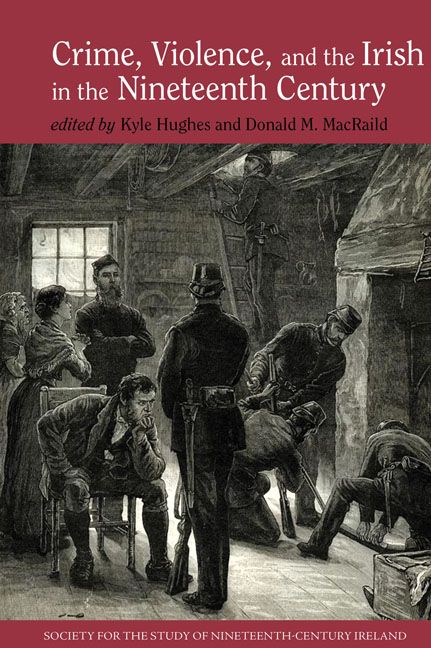Book contents
- Frontmatter
- Contents
- List of Illustrations
- List of Contributors
- Introduction: Crime, Violence, and the Irish in the Nineteenth Century; Themes and Perspectives
- Section 1 ‘Secret Societies’ and Collective Violence
- Section 2 The Law and its Responses
- Section 3 Sectarianism and Violence
- Section 4 Manifestations of Crime and Violence
- Index
Introduction: Crime, Violence, and the Irish in the Nineteenth Century; Themes and Perspectives
- Frontmatter
- Contents
- List of Illustrations
- List of Contributors
- Introduction: Crime, Violence, and the Irish in the Nineteenth Century; Themes and Perspectives
- Section 1 ‘Secret Societies’ and Collective Violence
- Section 2 The Law and its Responses
- Section 3 Sectarianism and Violence
- Section 4 Manifestations of Crime and Violence
- Index
Summary
There is much confusion over the extent of crime and violence in nineteenth-century Ireland. Historians are split on the fundamental question of whether Ireland was an inordinately violent place in comparison with other societies in the British Isles or in Europe. A.T.Q. Stewart thought violence was ‘endemic’ in Irish society and that this has been so ‘as far back as history is recorded’. Patrick O'Farrell depicted 1850s Ireland in the midst of ‘guerrilla warfare’ where landlords and their agents carried arms as a matter of course and ‘the peasants killed them when they could’. Alternatively, W.E. Vaughan has shown that landlords were rarely the victims of homicide during the period 1857–78; indeed, only two ‘landlords of the first rank’ were assassinated between the Famine and the Land War (the earl of Mayo in 1872 and Lord Leitrim in 1878). K.T. Hoppen notes that the ‘violence of pre-Famine Ireland was both less constant and less universal than has often been supposed’. Likewise, Charles Townshend suggests that violence in pre-Famine Ireland ‘was only remarkable by the standards of an imaginary rural idyll. By those of an urban industrial society it was almost trifling’. Mark Finnane has pointed out that Ireland conformed to wider Western European patterns and experienced a general decline in levels of violence after the middle of the nineteenth century.
Professional historians are sometimes guilty of providing unnecessarily complicated answers to seemingly straightforward questions. In this instance at least, there is some justification for the confused messages found in the historiography of Irish violence. For one, there is a distinct lack of sources to allow for the establishment of long-term Irish patterns in violent crime along the lines of Gurr's influential and much-critiqued review of Europe and North America. Moreover, the extant sources can be contradictory with, for example, discrepancies between outrage returns and judicial statistics. No two countries kept identical records and all employed a variety of different categories under the broad headings of crime and violence making UK and European comparison difficult.
- Type
- Chapter
- Information
- Publisher: Liverpool University PressPrint publication year: 2017



